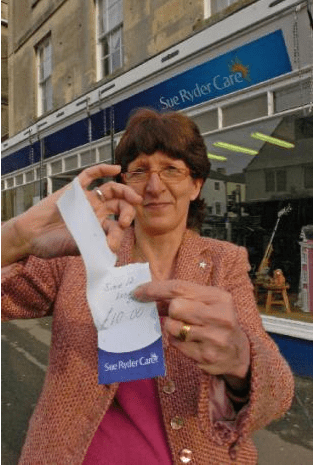Return to Melksham
Just before my short break, I had a very interesting conversation with Helen Reynolds of Sue Ryder Care about their pay what you choose pricing experiment in their Melksham charity shop.
This has been one of the most popular topics I've covered so I've started a blog string so new readers can speedily get up to date on the launch and the initial results – shops experiment.
And now with far more detail, I can share the thinking behind the test and describe what actually happened.
First off, this wasn't a test entered into lightly. Staff were fully aware of the possibly of the scheme being abused. Melksham was chosen because of the strong community nature of the town. Pretty much everyone who came into the charity shop was known by at least one of the staff or volunteers. Most importantly, everyone was trained on how to handle a selling process where the customer could decide the price.
As a result, the staff and volunteers weren't pawns in the experiment – they were actively involved. All were encouraged to engage with customers about their pricing decisions and were actually empowered as a result.
If someone asked if they could pay 10 pence for a ladies winter coat for example, they were told yes, if they honestly thought the coat was worth that amount. But the emphasis on how the answer was given left shoppers in no doubt how that 10 pence would be received.
The fact is the charity element of charity shop had a real impact on the outcome of the experiment. Choice was important, but if people paid too little they were simply taking from a local charity – nobody wanted to be in that position.
The engagement with customers was key to the success of the experiment. Staff and volunteers learnt about why people were buying certain items. If someone needed a pair of school shoes or a young family had moved into their first home and needed pots and pans, the price would reflect the buyers need.
Helen spoke of the words of Lady Ryder in respect of this:
"Our work is a summons to seek out and face the reality of human suffering and do something about it."
Staff were able to help those members of the community who were in greatest need and appreciated the chance to do so. As a result, the morale in the shop went sky high.
But more importantly, once they understood what customers wanted, they could up-sell. And now that final sales have been analysed, it is the increase in the units / transaction that has made the real difference. Sales are up by 21.5% in comparison with the two weeks preceding the experiment.
Across the board, Helen feels that people paid slightly less than when items were ticketed. But placed this into context by drawing attention to the fact that it is possible to buy new items from low cost retailers like Primark for little more than the cost of second hand goods at a charity shop. With men's shirts going for £6 and ladies' cardigans for £8, she isn't wrong.
This has caused a re-think on pricing policy. With customers increasingly comparing prices as the recession hits the high street, there is a trickle down that reaches to charity shops. One of the great things about the experiment was that it acted as a market research exercise into price sensitivity that allowed Helen and her team to hit the sweet spot when items were re-ticketed.
The experiment also increased footfall with many new customers attracted into the store. This was driven by a combination of local press coverage, word of mouth and promotional materials. It's interesting to note, that people didn't pop in just once. There were a large number of repeat visits as new stock was moved to the shop floor.
As for the overall impact of the recession on donated goods, Helen feels that generally donations are down, but not significantly. Some shops in her area were stock rich and some stock poor. With the aid of a van, stock is distributed to where the need is greatest. If there is a shortfall, it is on books. This isn't an immediate problem but come the summer holidays, they will sell out very quickly.
And as to whether the experiment might be repeated, Helen was relatively bullish. The results had been so pleasing that it may well be considered again and not just for Melksham. With the right people and right location tests could be undertaken elsewhere.
But above all, the key learning was in the level of engagement that was created. As in any charity / donor relationship, the closer people are brought together, the greater the positive impact.
Tags In
The Essentials

Crack the Code to Regular Giving: Insights, Strategies, and a Special Giveaway!

‘Tis Halloween. Keep to the light and beware the Four Fundraisers of the Apocalypse!

Why do people give? The Donor Participation Project with Louis Diez.

A guide to fundraising on the back of a postcard

What does the latest research tell us about the state of fundraising?






